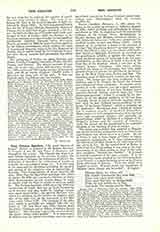

Veni Creator Spiritus, “the most famous of hymns” (Frere), is assigned in the Roman Breviary to Vespers (I and II) and Terce of Pentecost and throughout the octave. The Church also sings it at such solemn functions as the election of popes, the consecration of bishops, the ordination of priests, the dedication of churches, the celebration of synods or councils, the coronation of kings, etc. It is also sung in the more private devotions attending the opening and closing of the scholastic year in institutions of learning. The Congregation of Rites decreed (June 20, 1899) that the Eastertide doxology (Deo Patri sit gloria—Et Filio qui a mortuis—Surrexit ac Paraclito—In saeculorum saecula) should always be used, no matter what the feast or season of the year might be. The Vatican Graduale (1908) gives the older text (attestation of which does not go back beyond the ninth century) and also, under the heading “secundum usum recentiorem”, the present Breviary text, which is a revision, in the interest of classical prosody, of the older text, by the correctors of the Breviary under Urban VIII. The doxology of the older text (which is probably not original with the text itself) is: “Sit laus Patri cum Filio-Sancto simul Paraclito—Nobisque mittat Filius—Charisma Sancti Spiritus”. This doxology is generally associated with the hymn “Beata nobis gaudia”. It is unnecessary to indicate here the points of revision, since the printing of both texts in the Vatican Graduale makes comparison easy. Hymnologists think the revision uncalled for.
Dreves (Analecta Hymnica, L, 195) places the hymn in the section he devotes to Rabanus Maurus (d. 856), Abbot of Fulda and Archbishop of Mainz, and shows (p. 194) the importance of the manuscript evidence in his favor. Frere (Introduction to Hymns Ancient and Modern, historical edition, p. xxii) thinks the hymn can “with some confidence” be ascribed to him; as does also Blume (1908). Added support of the ascription is found in the scansion of the line “Qui Paracletus dicitur” (revised into “Qui dicitur Paraclitus”), where, in accordance with precedent found in Rabanus, Paracletus is accented on the penultimate syllable, as against the almost universal medieval custom of accenting it on the ante-penultimate, an illustration of which is found in the third line of the doxology (which is not part of the original hymn). Gueranger, with many others, ascribed the hymn to Charlemagne, but with slight ground except his zeal for the doctrine of the Procession of the Holy Ghost from Father and Son. The legendary story of Ekkehard V contains its own refutation. The hymn has also been attributed to St. Ambrose and to St. Gregory the Great, but without real evidence for either ascription. No ancient writer ascribes it to St. Ambrose, nor can a good argument be based on its inclusion of two lines (Infirma nostri corporis—Virtute firmans perpeti) from the “Veni Redemptor gentium” (which is certainly by St. Ambrose) or on the phrasal similarity of its two lines “Accende lumen sensibus—Infunde amorem cordibus” with the line “Infunde lumen cordibus” of the hymn “O lux beata Trinitas” (which is probably by St. Ambrose). Borrowing from celebrated hymns was a common practice of medieval hymnodists. Mone ascribes it to St. Gregory because of its classical meter and occasional rhymes, and especially its prayerfulness, which he declares is a feature of St. Gregory’s hymns; and the scansion of Paracletus (with the accent on the penultimate) he considers referable to the learning of such an author.
The hymn was probably first assigned to Vespers. One eleventh-century manuscript has it at both Lauds and Vespers, two others have it at Lauds. Its use at Terce is said to have begun at Cluny—a highly appropriate assignment, as it thus commemorates the descent of the Holy Ghost at the third hour of the day (Acts, ii, 15). In the council held at Reims in 1049, Pope Leo IX presiding, it was sung at the commencement of the third session in place of the ordinary antiphon, “Exaudi nos, Domine”. It is found in several pontificals of the same century. It is the only Breviary hymn retained by the Protestant Episcopal Church, a translation being given in the Prayer Book (Ordering of Priests). There are about sixty English versions. Warton styles the translation of Dryden “most elegant and beautiful”. It begins:
Creator Spirit, by whose aid
The world’s foundations first were laid,
Come visit every pious mind,
Come pour Thy joys on human kind;
From sin and sorrow set us free,
And make Thy temples worthy Thee.
H. T. HENRY

